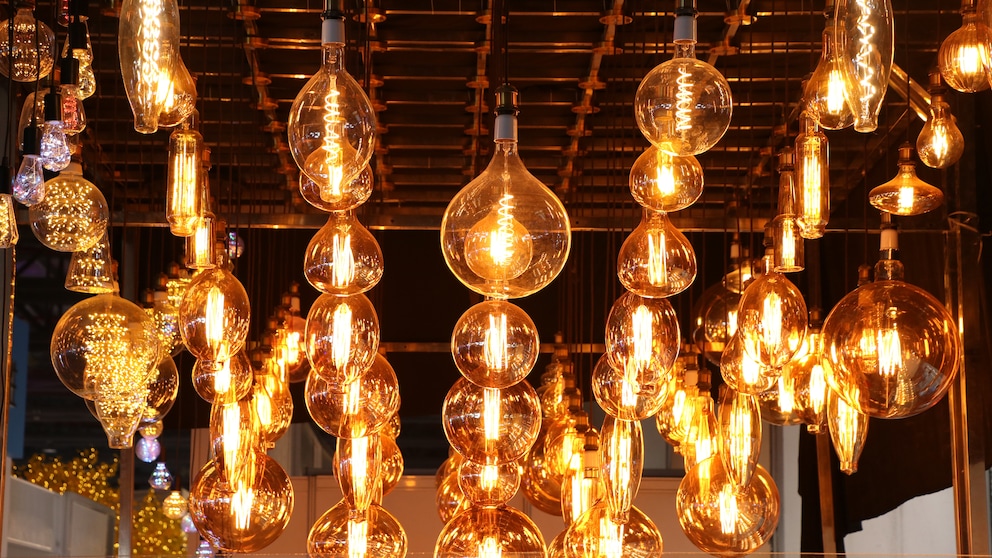April 19, 2025, 11:53 am | Read time: 5 minutes
Lumen, Kelvin, efficiency class, halogen, LED—when buying a light bulb today, you first need to understand the technical jargon. In the comprehensive myHOMEBOOK guide, you’ll learn everything you need to know about lighting products.
It’s well-known by now that traditional incandescent bulbs have been off the market for some time. Halogen lamps are also a thing of the past: An EU regulation removed them from the market at the end of 2018. If you still find them in stores, they are either leftover stock or specialty lamps, such as those for ovens, for which there is no LED replacement yet. In the past, it was simpler—the wattage clearly indicated brightness: 100 watts meant quite bright, 30 watts rather dim. Today, different rules apply, and LED light bulbs dominate the lighting market.
These Are the Advantages of LED Light Bulbs
LED lights (short for “light-emitting diode”) are initially more expensive than the good old incandescent or halogen lamps, but they consume up to 90 percent less energy. They also last longer and are shock- and vibration-resistant. Despite the higher purchase price, you save real money in the long run. LED light bulbs are categorized into efficiency classes, ranging from A++ (very efficient) to E (less efficient).
Do LED Light Bulbs Fit into Old Sockets?
The new LED light bulbs can also be screwed into conventional lamp sockets. For every halogen lamp, there is now a corresponding LED model with the same socket. What confuses many is the variety of different designs. Generally, they can be divided into screw and plug sockets. The numbers in the socket designations indicate either the diameter for screw sockets or the pin spacing for plug sockets.
The E designation indicates the appropriate screw thread:
- E14: An LED lamp with this designation fits into a small socket of 14 millimeters, commonly referred to as a candle socket.
- E27: This is a large socket with 27 millimeters, comparable to the base of a traditional incandescent bulb, also known as a general-purpose lamp. They typically fit into the socket of a standard lampshade.
- E40: These are oversized sockets with a diameter of 40 millimeters. They are rarely used in households.
Bulbs with a plug socket—also known as pin bases—are identified by the G designation:
- GU10: With this base, two pins are inserted into the corresponding socket and slightly twisted. Hence, it’s also called a bayonet mount. These are often used in ceiling lights and LED spots.
- G5.3: This plug socket with two pins spaced 5.33 millimeters apart is used for low-voltage LED spots with a transformer. Do not confuse it with the much larger G53 socket!
- G13: This refers to fluorescent tubes—also known as neon tubes—for 230 volts. Therefore, they are also called tube bases.
- G9: These sockets are mostly found in small lamps and originate from the earlier high-voltage halogen lamps. They have no pins but U-shaped wire loops.
How Is Brightness Measured in LEDs?
With old incandescent bulbs, brightness was indicated by wattage. For LEDs, you need to look at the lumen unit on the packaging. This unit indicates how much light the lamp emits. Here’s how watts and lumens correlate:
- 400 lumens correspond to a 40-watt incandescent bulb
- 800 lumens correspond to a 60-watt bulb
- 900 lumens are about as bright as a 75-watt bulb
Light Color—Do LEDs Emit Cooler Light?
Many associate LEDs with cool light, but that doesn’t have to be the case today. To choose the right color temperature or light color, you should pay attention to the Kelvin number. For comparison: A normal candle flame has about 1500 Kelvin, while the morning sun is around 5000 Kelvin.
- Warm white light color (below 3300 Kelvin): A warm white light color creates a cozy atmosphere, for example, in the living room and bedroom.
- Universal white light color (3300 to 5300 Kelvin): A neutral white or cool white light is ideal for the bathroom, for example.
- Daylight white light color (above 5300 Kelvin): This bright light intensity is well-suited for the study or office.
Can I Dim the Light with LEDs?
There are continuously dimmable LEDs available with the appropriate electronics, and many models can even change color. The right lighting mood can also be integrated into many smart home systems and controlled via smartphone or voice command.
Whether an LED lamp is dimmable is usually indicated on the packaging. But be careful: Not all models work smoothly, especially if a transformer is used in the lighting system. Either the dimming function doesn’t work or only works with a persistent buzzing noise.
Tip: Seek advice from a specialist retailer if you’re unsure, and ask if the lamp is compatible with your lighting system.

These Things That Make a Living Room Look Cheap

These Are the Decorating Trends for Spring 2025

How the “clean chic” trend ensures greater well-being at home
How Do I Dispose of Old Bulbs?
You can dispose of used incandescent bulbs in the household trash. Old LEDs and energy-saving lamps, however, should not be thrown away—they should be returned to a collection point. This is usually the store where you bought the lamps. You can also dispose of the old lamps at a recycling center. Although LED lights do not contain mercury like energy-saving lamps, their components are valuable enough to be recycled.

